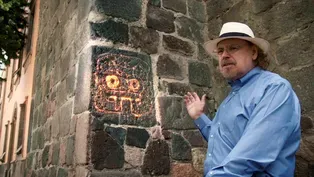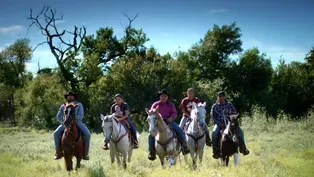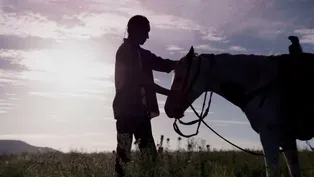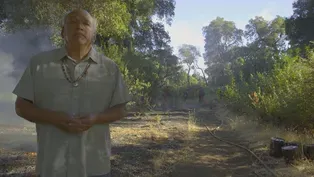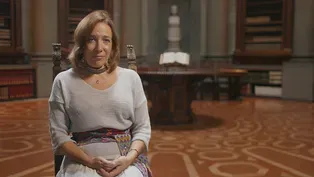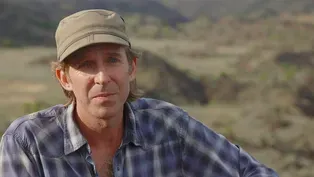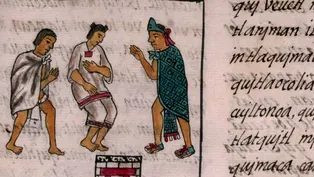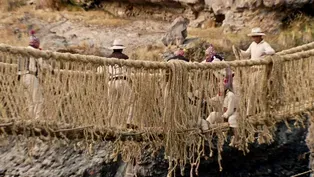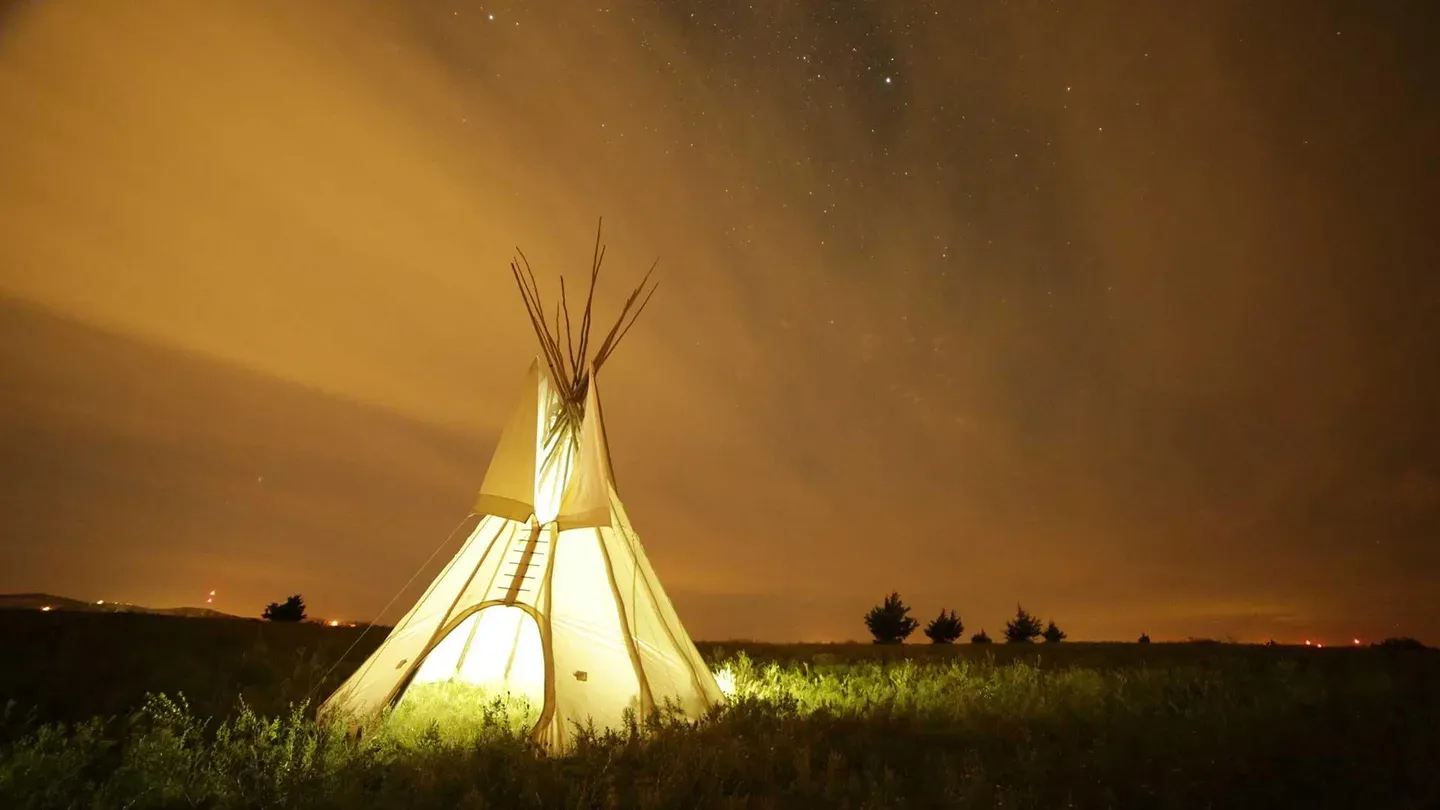

New World Rising
11/13/2018 | 53m 30sVideo has Audio Description, Closed Captions
Discover how resistance, survival and revival are revealed.
Discover how resistance, survival and revival are revealed through an empire of horse-mounted Comanche warriors, secret messages encoded in an Aztec manuscript and a grass bridge in the Andes that spans mountains and centuries.
See all videos with Audio DescriptionADProblems with Closed Captions? Closed Captioning Feedback
Problems with Closed Captions? Closed Captioning Feedback
Funding is provided by Partnership with Native Americans.

New World Rising
11/13/2018 | 53m 30sVideo has Audio Description, Closed Captions
Discover how resistance, survival and revival are revealed through an empire of horse-mounted Comanche warriors, secret messages encoded in an Aztec manuscript and a grass bridge in the Andes that spans mountains and centuries.
See all videos with Audio DescriptionADProblems with Closed Captions? Closed Captioning Feedback
How to Watch Native America
Native America is available to stream on pbs.org and the free PBS App, available on iPhone, Apple TV, Android TV, Android smartphones, Amazon Fire TV, Amazon Fire Tablet, Roku, Samsung Smart TV, and Vizio.
Buy Now
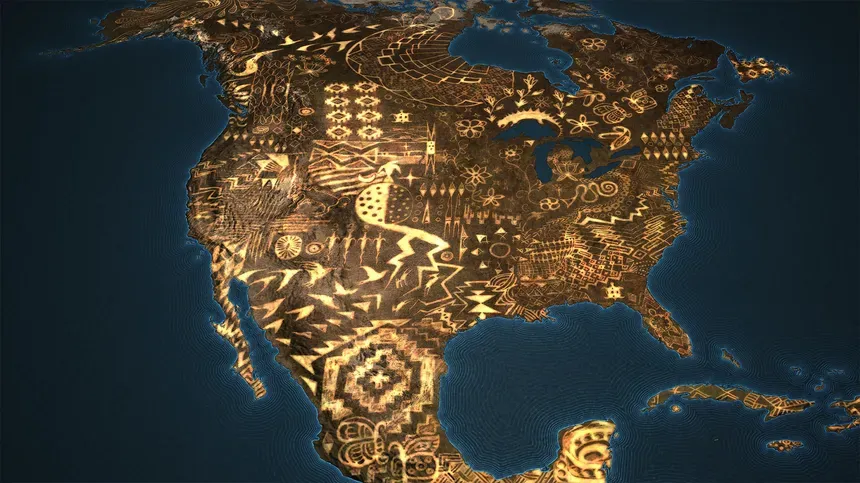
Listen to Native Voices
Explore an interactive map, which features speakers of Native languages in their own voices from across North America.Providing Support for PBS.org
Learn Moreabout PBS online sponsorship♪ ♪ (birds chirping) NARRATOR: The New World isn't new at all.
By the time Columbus arrives in 1492, this land is home to 100 million people.
♪ ♪ Their ancestral roots stretch back more than 13,000 years.
They live in hundreds of nations across two continents, linked by social and cultural networks.
(exhales) They invent unique systems of science, art, and writing; build some of the world's largest cities aligned to the stars; and create governments from empires to America's first democracy.
TOM PORTER: Thomas Jefferson had no idea of what democracy is till he came here.
♪ ♪ NARRATOR: Native Americans create another world.
♪ ♪ Then, the Europeans arrive.
♪ ♪ BEAU DICK: They tried their best to annihilate us completely.
NARRATOR: Native Americans face a deadly crusade to wipe them out.
(chanting) We're often referred to in the history books in the past tense, but we are not dead.
NARRATOR: Today they number 50 million across North and South America.
They maintain deep ties to their long history in this land.
(horse neighs) JHANE MYERS: I can't walk these same lands and be here where my people were without trying to acknowledge their existence.
NARRATOR: To fight the forces of conquest, Native Americans tap 10,000 years of beliefs and traditions.
At the intersection of modern scholarship and Native knowledge... (blowing note) ...is a new vision of America and the people who built it.
This is Native America.
If you have enemies hunting you down, the Rio Grande Gorge, west of Taos, New Mexico, is the ideal place to hide.
High mountain cliffs, steep rocky slopes, and deep valleys covered in scrub brush make this unwelcoming terrain-- except to bighorn sheep.
But the inhospitable landscape is why Severin Fowles and Jhane Myers are here.
They are on the trail of a fearsome Native American people that dominated the American Southwest for centuries and used this gorge to elude capture.
They are a people known as the Comanche.
♪ ♪ Comanche tradition says this gorge was once a home, the landscape dotted with hundreds of tipis, thousands of people, and across their lands, tens of thousands of horses.
(horses neighing) Yet this powerful people are famous for disappearing-- quickly breaking camp and leaving no sign they were ever there.
(bird calling) FOWLES: For so many decades, archaeologists have walked over this landscape and actually never found any evidence of the Comanche on the ground.
MEYERS: Well, the Comanches, by having the horse, it made them so mobile.
They were able to just pack up their camp and move.
Well, and that makes it one of the great archaeological challenges.
NARRATOR: Sev is an anthropologist from Barnard College in New York.
Jhane is a Comanche artist and cultural adviser.
FOWLES: We just didn't have the eyes to see their traces on the ground.
It took working with the tribe to be able to identify this site as a center of Comanche activity.
♪ ♪ Together they are finding the first physical evidence of the ancient Comanche: images etched in stone.
In the art is something that changes the history of Native America: the horse.
You're looking at a swarm of scratches, but as you look closer, you'll start to pick out the way all of these horses have been depicted by these lines that sort of swoop across, and they're each being ridden by these warriors with feather headdresses coming out behind.
(horse neighs) (man calling in Native language) NARRATOR: Today, the image of Indians on horseback is iconic.
But Native Americans never set eyes on a horse before the 15th century, when Europeans bring them to America as a weapon of conquest.
The Comanche and other Native peoples adapt the horse as a powerful ally in the fight to protect their land and way of life.
WOMAN (in Native language): (chanting, hooves pounding) (horse neighs) This rock art tells a story.
This is commemorating an event, a very successful horse raid.
♪ ♪ We're looking at possibly the beginning of our empire as Comanche people on horseback.
It's just amazing.
♪ ♪ NARRATOR: The panel is just one of hundreds found in this gorge created by Jhane's ancestors.
These images and Comanche oral history are rewriting the story of Native America in the wake of European colonialism.
With the horse, the Comanche transform themselves from small wandering bands on foot to a mighty mobile nation.
(hooves pounding) Through breeding, trading, raiding, and expert horsemanship, they dominate everyone in their path and rule an empire across the American West.
FOWLES: The Comanche didn't merely seek to put up with colonialism.
They wanted to do more than just survive.
They wanted to expand, they wanted to grow, they wanted to innovate.
They wanted to build a new world.
NARRATOR: And the Comanche are not alone.
(water rushing) From the mountains in Peru... (bell rings) (chanting) To the forests of California... ♪ ♪ To the plains of the Southwest...
Native peoples fight and survive.
♪ ♪ In the face of genocidal warfare and devastating disease, how do the Comanche and other Native Americans keep their beliefs and people alive?
♪ ♪ This is ground zero of the European invasion: a Catholic church built on the ruins of an Aztec temple in Mexico City.
♪ ♪ Davíd Carrasco, a Mexican-American historian of religion at Harvard Divinity School, is on the very spot where, in 1521, Spanish conquistadors slaughter 40,000 Native warriors, and the last Aztec emperor surrenders.
It is the end of nearly a century of Aztec rule.
The Spanish force Aztec workers to destroy their own temple, and with its stones construct the church in its place.
Spaniards knew that the site itself was sacred, and therefore they wanted to build their church on the same site.
NARRATOR: This church marks the military defeat of the Aztecs, but it is also the place where the battle for people's souls begins.
CARRASCO: When the Spaniards came to Mexico, what they really wanted was spiritual conquest.
They wanted to get inside of the Aztec mind and replace their own way of thinking with the Spanish, European, Catholic way of thinking.
(drum tapping) NARRATOR: Yet today, these dancers and millions of Mexicans celebrate the clash and fusion of these two cultures.
(drum tapping) Aztec beliefs do survive, and the fight to keep them alive starts here, with powerful symbolic acts of resistance.
Builders take a stone with the face of an Aztec god from their temple and embed it into the church.
CARRASCO: The masons who constructed that church reutilized Aztec stones in the very foundation and walls as a way of saying, "Yes, we may be becoming Christians, "but we're Christians of another sort, and we still believe in and worship our gods."
NARRATOR: But there is no place for other gods or Native ideas for the European invaders.
A year after contact, in 1493, the Vatican attacks the Americas with the "Doctrine of Discovery," proclaiming Europeans can take Native lands and kill or enslave so-called savages if they don't convert to Catholicism.
♪ ♪ The Spanish pillage gold and riches for themselves, their monarchs, and the church, and set out to eradicate thousands of years of Native beliefs.
CARRASCO: This was the place where Spaniards set up a school in order to train the surviving children of the indigenous nobles into education of European style.
NARRATOR: A Spanish priest, Friar Bernardino de Sahagún, takes a unique approach.
He believes the way to destroy Aztec belief is to first understand it.
He recruits Native artists to write and illustrate an encyclopedia of Aztec culture.
His intention is to help priests convert Natives, but the Natives have a different agenda.
(footsteps tapping) Today, the manuscript is a world away, in Italy.
It's called the Florentine Codex.
♪ ♪ DIANA MAGALONI KERPEL: It's 4,000 pages, perfectly handwritten.
2,000 and more images, dearly painted, and it has kept its secrets secret until very recently.
NARRATOR: For art historian Diana Magaloni, the 12 volumes of the codex offer a unique firsthand account of Aztec history and culture.
MAGALONI KERPEL: It is a voice that is never heard.
It is not our interpretation of the indigenous people.
It is their voices, their thoughts on history, and their point of view.
♪ ♪ NARRATOR: The Native authors chronicle the Spanish invasion.
♪ ♪ In 1519, Spanish soldiers bring 11 ships, 500 men, and 13 horses to Mexico.
♪ ♪ They plant the cross and embark on a campaign of conquest for God and country.
The Native authors write in Spanish on the left.
On the right, they use their own language, Nahuatl.
When Diana compares the two accounts, she discovers the Nahuatl tells a very different story.
The Native Nahuatl records in gory detail a massacre of unarmed Aztecs by Spanish soldiers.
♪ ♪ VOICEOVER (speaking Nahuatl): ♪ ♪ ♪ ♪ NARRATOR: The authors present a sanitized version of the story in Spanish, but in their native language, they secretly chronicle the bloody details.
MAGALONI KERPEL: There's subversion in the Florentine Codex, a very intellectual and potent subversion against colonialism.
NARRATOR: The Aztec artists use their own language to preserve their history and subvert the mission of the church and Europeans by chronicling the savagery of the conquerors.
♪ ♪ (men shouting, swords clashing) Almost 1,500 miles north, and 150 years later, the Comanche also leave a firsthand account of their clash with the Spaniards-- etched in stone in the Rio Grande Gorge.
♪ ♪ Each panel depicts a scene as if from a movie.
A Comanche tracker follows buffalo to a watering hole.
Warriors defend their village in an action-packed battle.
There's even a classic closing shot: A Comanche rides off into the sunset.
(horse neighs) The panel we're heading to is right over here.
NARRATOR: The stories come alive by deciphering the details.
Sev and Jhane join archaeologist Lindsay Montgomery, who is of Muskogee Creek heritage.
There is so much detail that the authors are putting into the panel, and every detail helps us kind of tell the story a little bit better.
NARRATOR: In this battle scene, the faint lines identify the fighters.
I am tracing the lines of what looks like the really distinctive style of headdress, with eagle feathers coming out the top.
NARRATOR: It's a style worn by the Comanche.
So what we get here is this great battle picture, with pedestrian warriors confronting a new kind of enemy, a mounted warrior from somewhere else.
NARRATOR: The Comanche are on foot, but the new enemy is on horseback.
MONTGOMERY: He has what looks to be a kind of metal helmet.
And then also his hand is on his hip, which is a real kind of power stance that Native people use to depict a foreigner.
And then what gives us a timestamp for this panel is what looks to be a gun.
NARRATOR: The gun is a common European musket, carried by a conquistador.
MONTGOMERY: We're seeing the first encounter between the Spanish here, the Comanche, and the horse.
NARRATOR: The rock art may memorialize a pivotal moment in history... ♪ ♪ a battle in which the Comanche seize the horse.
(people chanting and drumming) (horse snorts) (men chanting and drumming) ♪ ♪ WOMAN (in Native language): (chanting and drumming) (hooves pounding) (chanting and drumming) (chanting and drumming) NARRATOR: To the Comanche, the horse is a gift from the Creator.
FOWLES: They took this agent of imperialism and entirely turned it around.
They became the most expert horse breeders in a remarkably fast period of time, within one generation of being introduced to the horse.
(hooves pounding) NARRATOR: Before the Comanche got the horse, they were known by other names, including Numunu, "the people."
Around 1706 was the first reference of the people that we call today the Comanche.
MORGAN TOSEE: Hup!
ARTERBERRY: The name implies "those who like to fight."
The horse made us more mobile.
You know, it really sealed the identity of who we are today.
♪ ♪ (Tosee urging horse) NARRATOR: The Comanches' connection to the horse continues over generations, with descendants like Morgan Tosee, just outside Lawton, Oklahoma.
TOSEE: Get in the pen!
We're about the same two animals come together, humans and horses.
Just learned to get along with each other, work with each other, and help each other out.
NARRATOR: To the Tosee family, riding horses is a multi-generational affair.
(gate clanks) Today, Morgan's getting horses ready to parade in tomorrow's annual Comanche Fair.
TOSEE: Treat them good, and they'll be good to you.
(horse snorts) (crickets chirping) We'll breathe in their nose.
They know us from here.
Get used to us and they smell us.
They know who we are.
(crickets chirping) Well, here's your horses.
Oh, nice.
NARRATOR: Jhane and her son Phillip attend the fair every year.
TOSEE: Phillip, this is your horse right here, which you're gonna ride.
His name is Blaze.
Ah, Blaze.
TOSEE: This is your horse, Blue Eyes.
MYERS: Hey, Blue Eyes.
(Phillip and Myers talking softly) MYERS: Your great-great-great- grandmother loved riding horses.
When people were driving their cars into town on Saturday, she'd put on her buckskin and get on her Paint Horse and she'd ride to the town of Apache, Oklahoma.
So just remember that tomorrow when you're in the parade.
Ride with pride.
You're doing something that our people have been doing ever since the beginning of our time.
(horse snorts) NARRATOR: Sharing stories and traditions from generation to generation binds people and preserves culture in the face of colonization.
Such seemingly small acts are a strategy of resistance that spans the continents.
(blows note) PUMA QUISPE SINGONA: People in the Andes have been very clever, in spite of all the conquest and the colonization, to maintain our traditions thanks to the process of interweaving their belief system with the new belief system coming in.
♪ ♪ NARRATOR: The Spanish carry their cross and campaign for riches 3,000 miles south, and in 1533, defeat the largest empire in pre-Columbian America: the Inca.
♪ ♪ But high in the Andes, the conquistadors' quest to wipe out indigenous beliefs fails.
An ancient tradition-- a technological marvel-- survives unbroken to this day.
(people talking softly) (calling in Quechua) NARRATOR: Here in Q'eswachaka, 700 people from four villages gather to build a suspension bridge made entirely from grass.
(man calling) (rope strains and snaps) NARRATOR: Each year, the old bridge is cut down.
(crashes) And the villagers begin weaving a new one blade by blade.
♪ ♪ The villagers speak Quechua, once the language of the Inca Empire, and still spoken today by over eight million people.
GIRL (singing in Quechua): ♪ ♪ (singing): ♪ ♪ ♪ ♪ (man calls) (man talking) ♪ ♪ (calls) ♪ ♪ (men heaving) ♪ ♪ VICTORIANO ARIZAPANA HUAYHUA (speaking Quechua and Spanish): NARRATOR: Victoriano Arizapana Huayhua is a chakakamayoq, a traditional leader of the bridge builders.
HUAYHUA (speaking Quechua): (speaking Quechua) ♪ ♪ (river rushing) NARRATOR: The three-day ceremony literally bridges the past to the present.
♪ ♪ SINGONA: The Inca traditions, the Inca knowledge, has never disappeared.
It is still alive and it's not a spirituality, it's not a religion.
It's a way of life that we are still living in this way in all of our communities.
NARRATOR: Passing knowledge forward from generation to generation is a powerful weapon against colonization.
♪ ♪ In the Rio Grande, the Comanche are armed with thousands of years of learning the land.
Now with the horse, they take the fight to the European invaders.
FOWLES: This panel is a really extraordinary one.
What we're looking at are a whole array of armored horses.
You can see the warriors here with the war bonnet flowing.
Right.
The one thing that we haven't been able to understand, there's a sort of unusual figure over here.
It seems to be a kind of shield bearer, standing erect.
NARRATOR: Sev is hoping Jhane can shed light on a mystery: Among all these horses, why is one warrior standing?
Well, I think if you take this and you think about the context and how Comanches were great horsemen, when you turn it like this, the figure changes, and you see that it's another horse and rider.
♪ ♪ Well, that's a... That really resolves, actually, a number of inconsistencies in that figure.
You're right.
What we're looking at is a horse that's turned on its side.
So then overall, we're looking at... Circular motion?
(horse neighing) NARRATOR: The standing figure is actually a horseman turned on its side.
The rock art depicts a whirling attack formation.
U.S. cavalry reports the Comanche used this tactic to wreak havoc among the mounted troops.
This is precisely the kind of circle that we see in those 19th-century records, which makes this the earliest evidence we have of that kind of collective horsemanship.
NARRATOR: From the early 1700s to the mid-1800s, the Comanche turn the horse against the Europeans to continuously defeat them in battle.
FOWLES: The Comanche took some of the tricks of the colonizers and turned them entirely against them.
They did this by virtue of their mastery of the horse and the kind of equestrian movement that that enabled.
The horse provided an opportunity for the people to really, you know, raid and leave an area rapidly.
And the horse was an exchange item.
It was currency.
♪ ♪ The Comanche transform the horse from a weapon of European conquest, into the foundation of their own military and economic power.
(Tosee urging horse) NARRATOR: If anyone needed a horse, they had to buy it from the Comanche.
♪ ♪ FOWLES: They were moving over vast territories, to engage in a complicated economy that moved horses, captives, guns throughout the colonial world.
NARRATOR: In the mid-19th century, 300 years after contact, and for 75 years after the formation of the United States, the Comanche carry out raids nearly as far as Canada and Mexico City.
(horse neighs) They rule an empire from the Rio Grande into Oklahoma and from eastern Texas to the Rockies.
(birds chirping) They earn the title Lords of the Plains.
(horse whinnying) ARTERBERRY: American Indians are always portrayed as kind of this simple race of people, but when you think about the fact that the Comanches controlled a vast empire, controlling other tribes and other nations, even European nations, you know, that kind of puts it in a different light.
(indistinct chatter) NARRATOR: Yet today, etchings on the rock are some of the only physical evidence of their vast empire.
FOWLES: A lot of these squiggly lines.
The Comanche weren't interested in building monuments.
They were interested in commanding routes of movement.
And we see this in the rock art.
This is imagery that is really about the gestural movement over the rock.
They're moving lightly over the rock as they moved lightly over the land.
♪ ♪ NARRATOR: The Comanche's style of art-- with its quick, light gestures-- mirrors the way they live on the land.
(crickets chirping) And like the Comanche, the Aztec artists also find a unique way to encode their beliefs in the pages of the Florentine Codex-- color.
Diana Magaloni investigates the scene of the death of Moctezuma, the emperor who first meets the Spanish.
He was not a human being, he was a god, and his cape was made out of turquoise and the feathers of hummingbirds.
They used Maya blue, this beautiful color that is bright and powerful and the color of the Caribbean water.
But when they kill him, his cape has lost the Maya blue, the power.
He is as dark as the dark waters.
He is dead and with his death, his being god is lost.
NARRATOR: The absence of Maya blue evokes the physical death of Moctezuma as man and spiritual death as a god.
(drumming) But there is more to the color than meets the eye.
Through chemical analysis, Diana finds this blue is highly unusual.
16th century painters in Europe make paint with easily accessible inorganic materials like minerals.
But the Aztec artists create their paint, like blue, from living things-- orchid stems, parasitic insects, and extract of Brazil wood.
MAGALONI KERPEL: What they are doing in their paintings is actually using paints that have power.
They were actually creating images that had an energy in themselves.
♪ ♪ NARRATOR: There are over a thousand images in brilliant color in the codex, but in the final volume, there are only three.
The death of Moctezuma is one of them.
♪ ♪ The reason why is found in their account of the fall of the Aztec capital in 1521.
♪ ♪ MAN (speaking Native language): ♪ ♪ NARRATOR: European invaders bring a weapon more lethal than guns and horses-- they bring disease... ♪ ♪ Smallpox, influenza, bubonic plague, malaria, and many more to which Native Americans had never been exposed.
♪ ♪ Disease spreads quickly, and within 200 years, 90% of America's indigenous people die.
The population plummets from 100 million to less than ten million.
♪ ♪ It is among the largest population losses in history, as high as World War I and II combined.
♪ ♪ And as the Codex writers document how their ancestors succumbed to disease in 1521, they are struck by another deadly pestilence.
KEPLER: While they were doing these books in 1576, there is this pestilence.
They don't know what it is, but it's only killing indigenous people.
And so, death starts to take away all the people you know.
You are painting the book and perhaps your mother, your teacher, your best friend were dying outside.
NARRATOR: The stark, black and white images are more than just an artistic choice.
The artists, sick and dying, had no way to acquire the materials to make paint.
KEPLER: What they decided to do is to continue painting, use very little paint in specific images while the world around them was actually disappearing, like, in fact, disappearing.
♪ ♪ Many, many, many died.
NARRATOR: The codex authors fight to preserve their culture in words and colors.
NARRATOR: In the past, their ancestors had created cities, temples, statues.
They couldn't do that anymore.
What they had at hand was they were the keepers of knowledge.
And if they would portray that through paintings, that knowledge will be kept.
♪ ♪ NARRATOR: Pestilence rips across the Americas.
For centuries, the mobility of the Comanche helps them avoid the full impact of European plagues.
Then, in 1875, the U.S. army finishes what disease began.
They strike at the heart of Comanche power and identity-- their horses.
(drums beating) (men chanting in Native language) WOMAN (in Native language): (gunshots, horse whinnying) (gunshot) (loud gunshot) (horse whinnying) WOMAN (in Native language): ♪ ♪ NARRATOR: After U.S. troops slaughter the Comanche herd, Quanah Parker, the last free Comanche chief, surrenders.
♪ ♪ The Comanche are forced from their homeland onto a reservation called Fort Sill.
They become one of the more than 200 Native nations the U.S. removes from their land.
The original peoples of the Americas go from living freely across nearly two billion acres of the continental U.S. into just 50 million acres of reservations.
Nearly 98% of their territory is taken from them.
That same conquest mentality exists to this day.
♪ ♪ Sacred lands continue to be taken from Native people for oil, water, and minerals.
As recently as 2005, the U.S. Supreme Court cited the 15th century Vatican's Doctrine of Discovery to deny land rights of the Haudenosaunee, the people who created the first democracy in America.
TADODAHO SID HILL: For them to use that in the court of justice, to us, is exactly what justice isn't.
(tools scraping) BEAU DICK: They really tried their best to annihilate us completely.
♪ ♪ But guess what, we're still here.
And we haven't lost those values and those understandings that are so ancient.
♪ ♪ NARRATOR: Native Americans survive devastating disease and a concerted effort to kill them off.
How do they maintain their communities in the face of this historical trauma?
♪ ♪ You all come over here with me.
NARRATOR: Hutke Fields is the Principal Chief of the Natchez Nation, in modern Oklahoma.
FIELDS (speaking Native language): So I want you guys to follow me.
We'll gather the medicine while they watch the fire.
(speaking Native language): ALL: (speaking Native language): (birds chirping) NARRATOR: Hutke taps into knowledge preserved from the past to make medicine.
We need some green cedar, so we have to go over this way.
Well, here's one.
Here's another one we need.
Get a little bit of this cedar.
You can get one, yes.
FIELDS: These herbs, and plants, and roots that we use are important to keeping our people healthy while they're learning our traditions and customs.
You guys with those branches, bring them around here and put them by the pot.
There is a resurgence of effort to maintain our customs, and our traditions, and our languages.
Now I'd like to honor your families.
Hold your arms out.
♪ ♪ (puffs) ♪ ♪ (puffs) (exhales) ♪ ♪ FIELDS: I am going to offer a prayer and cleansing medicine so that these kids can continue their interest in their Native spirituality.
♪ ♪ The whole idea is to keep our relationship with our earth and our universe strong.
♪ ♪ If you've been doing it that way for 19,000 years, you ought to continue it.
♪ ♪ NARRATOR: Ancient medicine-making traditions are healing the Natchez Nation.
♪ ♪ Other tribes are reviving ancient practices to heal not just themselves, but also the land.
MAN: Coming in right here.
Right on, close on the edge of the line.
NARRATOR: In Northern California, the Amah Mutsun Tribal Band are reigniting a tradition that stretches back millennia.
(fire crackling) To fix the forest, they burn it.
Valentin Lopez is chairman of the Amah Mutsun.
VALENTIN LOPEZ: Our ancestors burned these lands.
It would generate tremendous seed germination and seed growth.
And so it would attract animals in and it would be easier for them to hunt.
NARRATOR: But, for more than a century, federal authorities banned the Amah Mutsun from working here.
It was devastating to the forest and its people.
We thought we were protecting this place as we could just kind of gate them off, say, "No people," leave them alone.
But what happened is the forests are getting overgrown, certain plants and animals have taken over, often from other countries, invasive species.
And so the Amah Mutsun, their practices, like fire, was a huge part of how they managed this landscape.
NARRATOR: Now, after decades of negotiation, the Amah Mutsun are burning again.
Creator, we are here.
Please hear our prayer.
(Lopez chanting in Native language, tapping) LOPEZ: Creator, for thousands of years our ancestors traditionally burned, Creator, and so today we have a fire here.
♪ ♪ LOPEZ: Creator, may that fire cleanse and purify these lands.
May it provide for new growth of our native plants, and may those plants provide for the birds, the insects, the four-legged, and for people themselves, Creator.
(blowing) We've got a nice, good controlled jump.
You just have to keep your eyes on some of those.
NARRATOR: California firefighters manage the fire, building what they call a controlled burn.
If you can just maybe give it a blast real quick, please?
Where do you want it?
Right up top.
There you go.
HELLER: What we've been learning is the way that Native American people were taking care of the land was actually a huge part of driving biodiversity.
♪ ♪ The fire keeps invasive species at bay.
(tapping) (Lopez chanting in Native language) LOPEZ: Our people learned by trial and error and observing the patterns of Mother Nature.
(chanting continues) They learned about the four seasons and the traditions and ways.
(chanting continues) And it was the power of observation that they acquired their knowledge and passed it on.
♪ ♪ NARRATOR: Fire is medicine for the land.
♪ ♪ This ancient practice rejuvenates the forest, and reviving traditions is resurrecting the Natchez and Amah Mutson people.
♪ ♪ (birds chirping) Back in the Rio Grande Gorge, the Comanche are reconnecting with their ancestral land.
Severin Fowles and Jhane Myers believe they are in the landscape that forged the Comanche.
Right over here.
NARRATOR: Now, they may have the evidence to prove it: tipis.
This is a panel, one of many panels up here that's depicting tipis, and this is a really excellent example of that.
FOWLES: We're looking at two giant, oversized tipis.
Here we can see the strip of the base of the tipi down at the bottom, the poles of the interior rising up all the way to the top, the smoke flap is open and then the tipi poles at the very top.
MYERS: Beautiful.
we still use the four-pole method that you see here.
Oh, right up here.
MYERS: Yes, that's how we frame the tipis up.
FOWLES: From an archaeological perspective, it feels like such a strong assertion of presence in this landscape.
♪ ♪ MYERS: Seeing this place makes me see that my people were here, this was our land, probably overlooking the tipis and an encampment down below with horses.
So it really makes me happy to see this.
NARRATOR: These images raise an incredible possibility.
FOWLES: It's as if the artist was sitting here looking out upon his horses, playing in the midst of a big tipi encampment and then depicting that scene on the rock.
NARRATOR: Sev suspects the etchings depict a Comanche settlement below.
There, Lindsay Montgomery finds stones arranged in circles.
MONTGOMERY: What we're finding here are tipi rings.
and you can kind of walk around it and see all the stones that have been placed in this circle here, which would have been used to hold down the hide for the tipi.
FOWLES: We've seen now a number of images of tipis scratched onto the rocks, but here we're now getting actual tangible evidence of those tipis on the ground.
NARRATOR: The stones reveal where tipis once stood.
FOWLES: This is a lovely one.
This is quite large in fact.
Yeah, it looks about four meters or so, and then you have the kind of entrance here facing to the east.
So would they have horses here?
Yeah, so we would imagine horses being kept in the middle of the tipi encampment.
MYERS: Nice.
♪ ♪ NARRATOR: Sev, Jhane, and Lindsay have identified the first physical evidence of a Comanche encampment.
MYERS: For me, as a Comanche woman, this just completes me, because all of my relatives were here.
They were here before us.
♪ ♪ MYERS: They probably prayed for us and, you know, prayed that someday we would be here and our culture would continue.
♪ ♪ MYERS: I can't walk these same lands and be here where my people were without trying to acknowledge them and acknowledge their existence.
So I want to offer to the four directions what I carry with me always.
It's a mixture of tobacco, which takes our prayers straight up to the creator, it's a mixture of Indian perfume which grows wild in our country.
♪ ♪ Thank you for praying for me.
(voice breaking): Thank you for praying for my children.
Thank you for having the courage and the strength to go through everything that you did... (sniffles) in order for us to exist and thrive as a people.
♪ ♪ NARRATOR: This secluded gorge was once a home to one of the most powerful people of the Americas.
At their height, they roamed freely across the American Southwest, numbering 40,000 people and tens of thousands of horses.
♪ ♪ (owl hooting) The Comanche people are still here.
(indistinct chatter) Half of their 15,000 members live around Lawton, Oklahoma.
What was once a reservation is now the center of the Comanche Nation.
(tapping) Thousands gather here each year for the Comanche Nation Fair.
♪ ♪ ♪ ♪ Like Jhane and her son Phillip, the people honor traditions by passing them forward to the next generation.
♪ ♪ (children's excited chatter) (chanting in Native language) ♪ ♪ MYERS: I know my grandmother is looking down and smiling, and all the things that she taught me I've taught my children.
And to be able to wear my outfit today, it just makes my heart happy.
♪ ♪ I want people to see us and just think, "Oh, my gosh, "that person is Comanche.
"Those people, they're not historical, "they're still alive today.
Look, they are thriving."
NARRATOR: And the spirit of the horse remains at the heart of the Comanche Nation.
When the moon is full, the Comanche believe those mustangs massacred in the Texas panhandle still run free.
WOMAN (in Native language): ♪ ♪ WOMAN (in Native language): NARRATOR: The Comanche and Native peoples across the Americas keep traditions alive and tap ancient knowledge to ensure their future.
(speaking Native language): (speaking Native language): ♪ ♪ FIELDS: It was our tribal beliefs, our customs, traditions, languages that helped keep us together, that helped us survive.
NARRATOR: Even the Florentine Codex, meant to convert indigenous people to Christianity, ends up preserving Aztec culture.
MAGALONI KERPEL: It is not only preservation, it is almost like a magical preservation.
Once you inscribe something in a sacred book of time, it was the belief things would exist, continue to exist.
♪ ♪ FOWLES: When Europeans first came over to the Americas, the first thing they did was to take the cross and plant it in the ground.
And that sense of being able to take the rituals, the practices, the relationships of one place and transplant them whole cloth into another landscape, that's foreign, that's strange.
♪ ♪ For Native peoples, when you move into a new landscape you become a new type of person.
You enter into a new kind of religious relationship with the land.
(exhales) SINGONA: The spirituality of our Inca ancestors lives in our way of life.
In the way that we remember where we come from in order to have a stronger presence in this world.
(blowing horn) ♪ ♪ NARRATOR: When Europeans step onto these shores, they are blinded by narrow ideas of wealth and religion.
They don't see the richness and true value of Native America.
♪ ♪ Thousands of years of advanced knowledge built into cities aligned to the sun moon and stars.
♪ ♪ Experimental agriculture producing new foods-- potatoes, corn, and more-- enough to feed a hundred million people.
And radical ideas about governments that serve the people that will later inspire the U.S. Constitution.
Native Americans create a way of life that is both a scientific understanding of nature and a spiritual quest to find their place within it.
♪ ♪ RONALD WADSWORTH: We were taught to live in balance with nature.
Each individual has tremendous power to change his world.
We are a microcosm of the universe itself, so how we behave, how we take care of ourselves, reflects in the earth.
LEIGH KUWANWISIWMA: We today live under one life philosophy which is principled upon compassion, reciprocity, stewardship, and really about humility.
♪ ♪ JIM ENOTE: The world lives with us.
We live with it.
♪ ♪ But we have to maintain it.
We have to take care of it in order for it to provide for us.
♪ ♪ NARRATOR: Native knowledge and ways of life are rooted in the birth of this world tens of thousands of years ago.
♪ ♪ (eagle screeching) (chanting in Native language) ♪ ♪ The ideas that built Native America are still here, alive in the land and the people.
♪ ♪
Video has Closed Captions
Resistance begun by Aztec builders continues through today. (2m 6s)
Video has Closed Captions
Horses continue to be an important part of Comanche identity and tradition. (1m 59s)
Episode 4 Preview | New World Rising
Video has Closed Captions
Discover how resistance, survival and revival are revealed. (30s)
Extended Interview: Burning a Forest to Revive a People
Video has Closed Captions
Valentin Lopez, of the Amah Mutsun, uses fire to save his peoples culture. (3m 23s)
Extended Interview: Diana Magaloni on the Power of Pigments
Video has Closed Captions
Illuminating the extraordinary measures Aztec artists took to record their culture. (2m 52s)
Extended Interview: Evidence of the Comanche
Video has Closed Captions
With help, the archaeologist finds evidence of the illusive Comanche. (2m 15s)
Extended Interview: Severin Fowles on Native Science
Video has Closed Captions
Archaeologist Severin Fowles re-imagines Native religion as Native science. (1m 25s)
Video has Closed Captions
How the Aztecs used color to represent the aftermath of colonialism. (1m 8s)
Video has Closed Captions
In Peru, people still build traditional Inca grass bridges. (3m 2s)
Providing Support for PBS.org
Learn Moreabout PBS online sponsorshipSupport for PBS provided by:
Funding is provided by Partnership with Native Americans.
